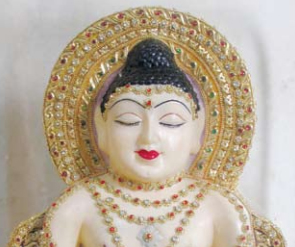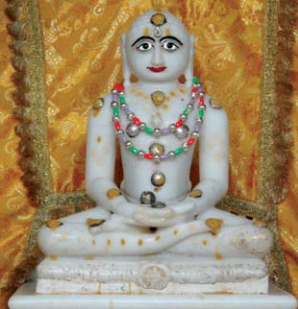
Centre of Jaina Studies Newsletter: SOAS - University of London
The Jain Studies Group of the American Academy of Religion (AAR) sponsored two sessions at the 2012 annual meeting in Chicago, Illinois, on November 1720.
The first session, entitled "Jains, Muslims, Christians: Interrogating Religious Borders in Sultanate, Mughal and Colonial India," was co-sponsored with the Religion in South Asia Section. There has been a Muslim presence in western India since the Arab conquest of Sind in the eighth century, and then the spread of Arab and Muslim merchants in subsequent centuries. Interaction among Jains and Muslims was extensive. Muslim merchants and Jain merchants operated side-by-side throughout western India and the Indian Ocean. At the same time, as Richard Davis has analyzed in Lives of Indian Images, Jain and Muslim texts often portrayed each other as the archetypal other: Jain texts portrayed Muslims as violent iconoclasts, and Muslim texts portrayed Jains as heathen idolators. When Sultanate and then Mughal rule replaced Rajput rule in Gujarat after the thirteenth century, the Jain merchants whose economic activities were vital to western India entered into a new relationship with Muslims, especially Mughal rulers who often depended deeply upon Jain financing and economic activity.
The extant evidence of Jain-Christian interactions is from much later, after the coming of Christian missionaries to India under the protection of British colonialism. Gujarat was the site of extensive Irish Presbyterian missionizing from the early years of the nineteenth century. As Jain merchants migrated in large numbers to the rising entrepôt of Bombay, and quickly became civic leaders in the new city, the Jains came into close interaction with Scottish Presbyterian missionaries there as well.
In "Jinaprabhasūri at the Court of Muḥammad bīn Tughluq," Steven Vose (University of Pennsylvania and Florida International University) questioned the historiography of medieval Jainism. Instead of a model that sees the Jains turning inward and away from engagement with dominant political structures, and focusing instead upon an increasingly bounded religious community, Vose argued that the Vividhatīrthakalpa of the Kharatara Gaccha Ācārya Jinaprabhasūri (ca. 12611333) shows the author confidently interacting with the new Tughluq rulers of northern and western India. Jinaprabhasūri successfully negotiated with Sultan Muḥammad bīn Tughluq for the return of an icon of Mahāvīra that had been looted by one of the Sultan's generals. He secured farmāns (edicts) from the Sultan that protected important Jain pilgrimage shrines, and granted Jains safe passage throughout the realm. Muḥammad bīn Tughluq established a Jain quarter in Delhi, and bestowed honors on Jinaprabhasūri.
Audrey Truschke (University of Cambridge), in "Dangerous Debates: Jain Responses to Mughal Theological Challenges," investigated the texts composed in Sanskrit by Śvetāmbar monks about the frequent visits of Jain monks to the Mughal court from the 1580s to the 1610s. These texts look at three different encounters. In one, the Jains were questioned about their understanding of Islam; their answers give us insight into Jain understandings of the nature of Islam in this period. In a second set of discussions in the royal court, the Jains were challenged to defend themselves from the charge of atheism. Different Jain texts recount different Jain answers, showing flexibility in Jain theological self-understandings. The third encounter involved a Jain monk refusing the emperor's order to take a wife, and the textual accounts of this dangerous refusal show how religious celibacy was an important marker of religious (and therefore social) difference in Islamicate India.

The paper by Mitch Numark (California State University, Sacramento) was "The Scottish 'Discovery' of Jainism in Nineteenth-Century Bombay." He focused on three Scottish missionary-scholars, who played major roles in the development of Orientalist scholarship in Bombay: John Wilson (1804-1875), John Murray Mitchell (1815-1904) and John Stevenson (1798-1858). Stevenson has long been credited with the first translations of Jain texts into English, with his 1848 publication of the Kalpa Sūtra and the Navatattva Prakaraṇa. Numark argued that the more substantial work of the other two has been largely overlooked in the historiography of Jain Studies. Through their extensive interactions with Jains in the multi-religious setting of Bombay, these scholars came to understand "Jainism" as a separate, distinct religion earlier than the better known Orientalists of Calcutta, whose writings had greater influence upon Orientalist and Jainological scholarship in Europe.
John E. Cort (Denison University), in "Defending Jainism against Christian Missionaries in Colonial Gujarat," looked at two Gujarati tracts written by the Śvetāmbar monk Ācārya Buddhisāgarsūri (1874-1925). The first was written in Surat in 1901, in response to an anti-Jain Gujarati tract written by Jaimal Padmīṅg, a former Jain monk who had converted to Christianity. The second was written in 1924 in Prantij, where Mrs Margaret Stevenson, author of The Heart of Jainism, was living with her husband Rev J. Sinclair Stevenson. He was in charge of the Irish Presbyterian Mission in the town. In the first tract, Buddhisāgar engaged in a vigorous defense of the Jain understanding of God as the dispassionate Jina, against the Christian charge that they were atheists. He also articulated a defense of the doctrine of karma in contrast to the Christian
faith in an active creator God. By the time of his second tract much had changed in India, so in 1924 we see Buddhisāgar also criticizing the Christian imperialists for enslaving colonized peoples around the world. In place of a Christian and colonial form of animal strength (paśu bal) based on the consumption of meat and liquor, Buddhisāgar argued for the superiority of spiritual strength (ātmik bal) based on a vegetarian diet.

The response to the four papers was delivered by Peter Gottschalk (Wesleyan University). While he is not a scholar of Jainism, Gottschalk brought to the panel his expertise in the complexities of HinduMuslim interactions and relations in modern India. He observed that all four papers investigated contexts in which political hegemony had in turn generated a degree of religious hegemony. The degree and form of these hegemonies, however, were not reducible to a single mode of religious politics. On the one hand, it would be a mistake to ignore the mélange of religious actors in the Tughluq and Mughal courts, and thereby offhandedly portray these courts as solely "Islamic." On the other, scholars must not overlook the many ways that British colonial rule in India was infused by an evangelical "Christian" character. Secondly, Gottschalk observed that the four papers taken together raised important questions concerning the rise and use of the intellectual and social category "religion." Did the Jains, Muslims and Christians see themselves and their opponents as belonging to comparable social groups, based upon comparable intellectual concepts known as "religions"? In what ways did the political hegemony of the Tughluqs, Mughals and British force their Jain interlocutors to adopt Islamic and Christian conceptions of "religion" in order to advance the social, political and economic interests of their communities? Manisha Sethi, Escaping the World: Women Renouncers among Jains. A Roundtable Discussion.
The second session was a roundtable discussion of Manisha Sethi's 2012 book, Escaping the World: Women Renouncers among Jains (New Delhi: Routledge India). John E. Cort (Denison University) first presented an overview of the book. Three panelists presented more detailed responses: Anne Vallely (University of Ottawa), Sherry Fohr (Converse College) and M. Whitney Kelting (Northeastern University). Finally, the author, Manisha Sethi (Jamia Millia Islamia), responded to the three responses.
At the heart of Sethi's book is an investigation into a phenomenon that has been noted by many scholars: in contrast to the broader patriarchy of South Asia, and in particular in contrast to the lack of women among Hindu (and many Buddhist) renouncer traditions, there are large numbers of women in all the Jain renouncer traditions. Sethi's fieldwork and theoretical investigation, therefore, aim at "providing clues to understanding the sexism that lies at the core of the dominant ideologies that serve to disempower women in both religious and secular domains of life [in Indian society]. This work will hopefully advance our understanding of the role that social construction of gender plays in Indian social and religious life" (p. 3). Central to her study is an investigation of agency and choice in the lives of Jain women renouncers: the ways they articulate their own agency and choice, and the many ways that social structures of both family and renunciation shape and limit agency and choice.
Sethi argues that female renunciation among Jains is a "fractured discourse." It can be empowering to Jain women. At the same time, the necessary effacement of self and ego, and devaluation of the body, argues against too quickly seeing the Jain women renouncers as a case of "indigenous feminism." She concludes, "both householdership and asceticism are culturally prescribed roles for women. Asceticism is certainly an alternative for women, but one that is coded through Jain cultural values" (p. 220).
Anne Vallely responded from the perspective of symbolic anthropology and the phenomenology of religion. Vallely argued that Sethi's approach does not fully allow for the range of Jain nuns' voices to emerge. Sethi's discussion of the feminist critiques advanced by nuns in several of the more innovative Sthānakvāsī orders raises the possibility of a Jain internal model for resistance. However, equal if not more attention needs to be paid to the many more nuns who either view the feminist project as irrelevant to their own spiritual pursuits, or else are in partial or full agreement with the criticisms of female embodiment found in Jainism.
Sherry Fohr examined how Sethi's conclusions compare with previous scholarship that has directly or indirectly examined the main questions of her book concerning Jain nuns, in particular why so many Jain women renounce the world. In reviewing what scholars have written about Jain women, Fohr found that they all seem to agree on only three points: (1) It is acceptable and honorable for women to renounce in Jainism. (2) It is now mostly young unmarried women who renounce, in contrast to earlier patterns. (3) Jain women are more religious than Jain men. Fohr argued that this third point goes to the core of the question of why there are more Jain nuns than monks, for this question is another way of asking why Jain women are more religious than Jain men.
Fohr questioned to what extent differences of region, sect, gacch and sampraday influence the different findings. To what extent do the different modes of feminist analysis employed by the scholars influence their conclusions? To what extent do the methods of research, the questions they ask, and the people of whom they ask questions, influence the different conclusions? Or, Fohr asked, is the answer to the question of why there are more nuns than monks much simpler than the different analyses indicate? Perhaps there are more Jain nuns than monks for the simple reasons that Jain women are taught to be more religious, and that it is honorable for Jain women to renounce the world and become nuns.
Whitney Kelting urged us to see the narratives of world-rejection and renunciation, and the subsequent creation of an alternative space of mutual care and spiritual advancement, as just thatnarratives. Humans tell stories to explain choices they have made, and the stories can lend great meaning to those choices. The researcher, however, must walk a fine line between accepting the narratives of renunciation at face value in order to respect the agency of the nuns telling the stories, and listening critically with the understanding that these narratives do not tell the whole story.
Sethi began her response by thanking Anne Vallely for foregrounding the ideological orientation of her book. The lives of Jain nuns present a dilemma to someone schooled in the liberal, left and feminist traditions. How does one make sense of women who have voluntarily embraced lives which many would deem as oppressive? Questions of choice and agency were therefore central to her work. The larger question that underlies her scholarship is how to reimagine, rethink and re-theorise women's choice and agency in non-western contexts.
Sethi expressed a concern that scholars should not end up creating their own set of binaries, in which they do not allow women such as the Jain sādhvīs the possibility of having a vision of female liberation. This vision may be significantly different from the vision of female liberation held by feminist scholars, but sometimes it may not be. It may be that only the mode of its expression is different. Sethi asked if scholars should see Jain nuns only as inhabiting norms, when in fact they could be simultaneously subverting those norms.
In response to Fohr's comments, Sethi turned to the question of to what degree can scholars of Jainism generalize on the basis of her work? How broadly applicable are her findings for addressing the reasons women enter Jain mendicant orders? While she was careful to include nuns from all sects and sampradāys, the most extensive fieldwork was carried out amongst groups of Tapa Gācch sādhvīs who at the time were based in Roop Nagar in Delhi, and a group of Sthānakvāsī sādhvīs who were spread out in parts of North Delhi.
Sethi said that the question she raises in her book is a historical one: How do we account for the numerical preponderance of nuns throughout documented Jain history? She does not think, however, that a trans-historical answer to that question is possible. She observed that patriarchies are continuously reconstituted, as is the meaning of being a Jain. Jain mendicant history has been rife with reforms, fissures and splintering over questions of practice if not beliefs. A single answer that addresses all these changing circumstances is therefore unlikely.
Sethi then turned to Whitney Kelting's comments. She agreed with Kelting that a woman's choice between dīkṣā or marriage is implicated in structures of patriarchy. She said that nuns themselves create an opposition between householdership and renunciation. Sethi found that for many nuns, interaction with laywomen, who visit them and confide to them the problems in their marriage and at home, routinely re-affirms the validity of their own choice and strengthens their own vairagyā. Sethi said that she found that many Jain laywomen, rather than valorize their choice to become wives and mothers, expressed regret at their lack of foresight and courage. They said that they should have recognized the true character of saṃsāra: a life of uncaring husbands, demanding children, and unending responsibilities. Sethi concluded her comments by quoting one of her informants, the nun Prafullprabhashriji, who had described the life of a nun: "No responsibility, no tension, no familial obligations... whatever you do, it is solely for your own spiritual uplift." At the same time, however, Sethi said that it is important to recognize that the nuns also privilege their ascetic identity over the feminine one.

 Prof. Dr. John Cort
Prof. Dr. John Cort